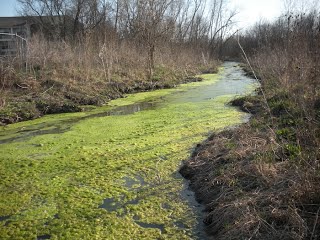This set of interconnected lessons takes us through the process of investigating surface water quality. The focus is on physical and chemical properties that can be easily studied with the minimum of specialized equipment (information on ordering test kits is provided). We begin by looking at nutrients. Nutrients are a major problem in the Kansas River watershed, but they can be confusing for us when we attempt to measure their concentrations in streams and ponds. This is because nutrients such as nitrogen and phosphorous are very quickly taken up by aquatic plants, algae, and bacteria. So quickly, in fact, that only an hour after a rainstorm washed high concentrations of nutrients into a stream or pond we may not find any nutrients left in the water. When nutrients run off into a stream or pond they are rapidly taken up by algae and can trigger an algal bloom, making it obvious by the look and smell of the water that there are a lot of nutrients in the system--but when we measure the water with our students we often get no readings on the test strip. This can lead to the incorrect conclusion that there isn't a nutrient problem, which is confusing to students given the obvious algal scum that they see on the water. So, unless we measure the water while the nutrients are actually flowing into it we will not find nutrients freely available to measure in the water. If we found a pipe from a sewage treatment plant that had water high in nutrients coming out of it, or we were to collect water running off of a fertilized lawn during a rainstorm, then we would get positive test results (and we don't recommend you do either with your students!). We face the interesting problem that we may have obviously eutrophic (nutrient enriched) ponds that test zero for nutrients when our students do their water testing, and this seemingly contradictory set of observations means that we have to delve into the issue more deeply. We designed this section to produce a sequence of questions and answers about nutrients that lead us to an understanding of the dynamic nature of nutrient cycles in surface waters. In order to make the experience of water testing interesting and informative, we have developed a series of lessons that build on each other; first we go over how to use our basic senses to look at water quality (Odor, Color, Foam), then we measure the Temperature and pH, which will help us interpret the nutrient tests. We explain how to measure Nitrogen and Phosphorous, then we explore Runoff and Nutrient Uptake to examine how terrestrial plants and aquatic algae remove nitrogen and phosphorous from stormwater. We then look at Bacteria, which also remove nutrients from the water column. Although it is difficult to measure the amount of algae in the water, it is relatively simple to measure bacteria, and we provide instructions on Bacteria Testing. Finally, we have designed a Stormwater Geocache Challenge to assess understanding of the material in a fun adventure. We hope that this approach will stimulate your students to think more deeply and critically about their observations of the world. We would like to thank Dr. Rhonda Janke and Rebecca Moscou from the Citizen Science program for their help in developing these lessons. |
|
|



